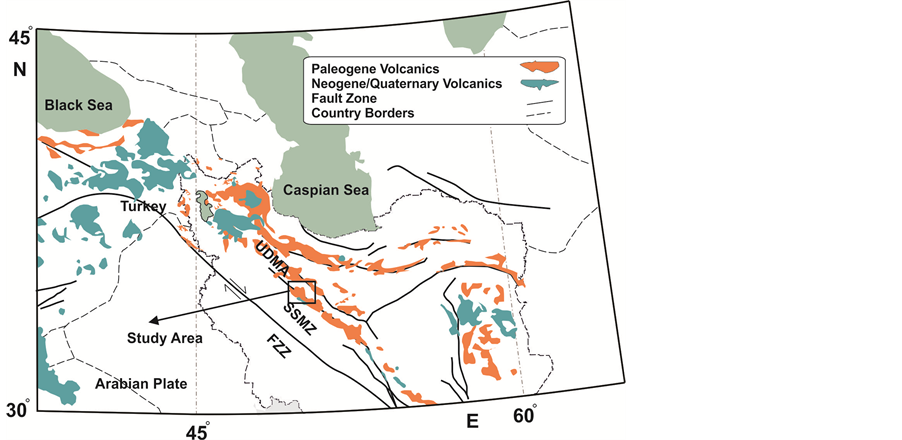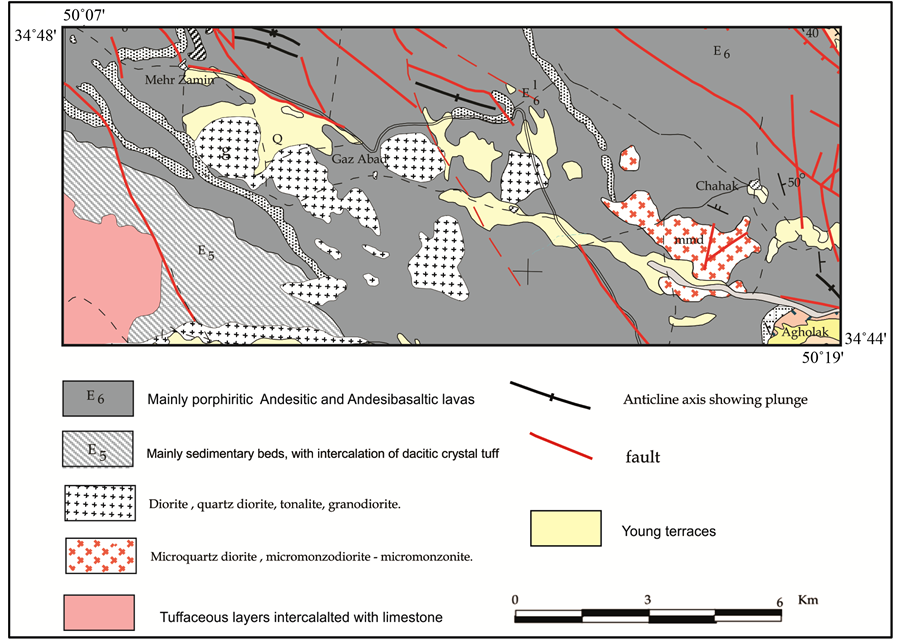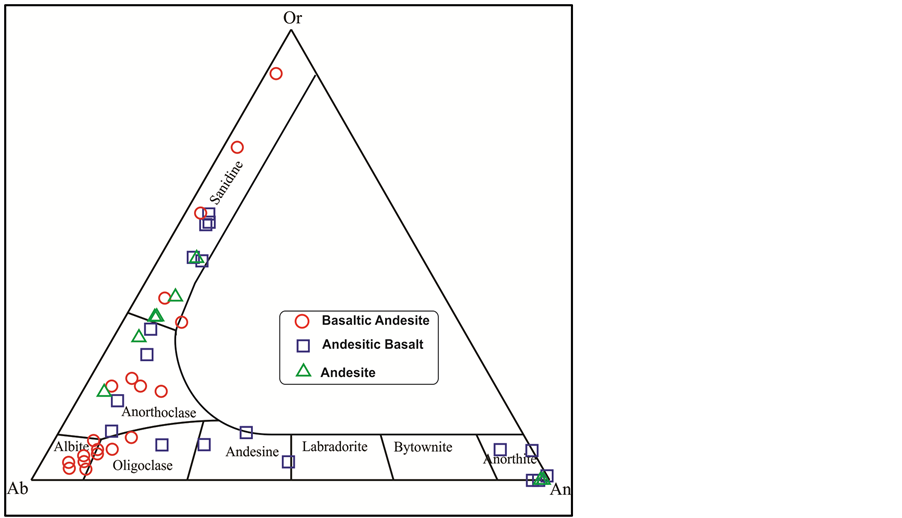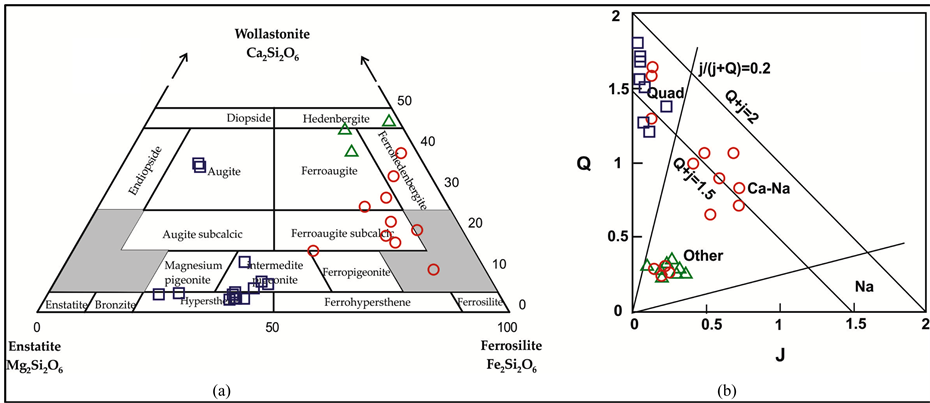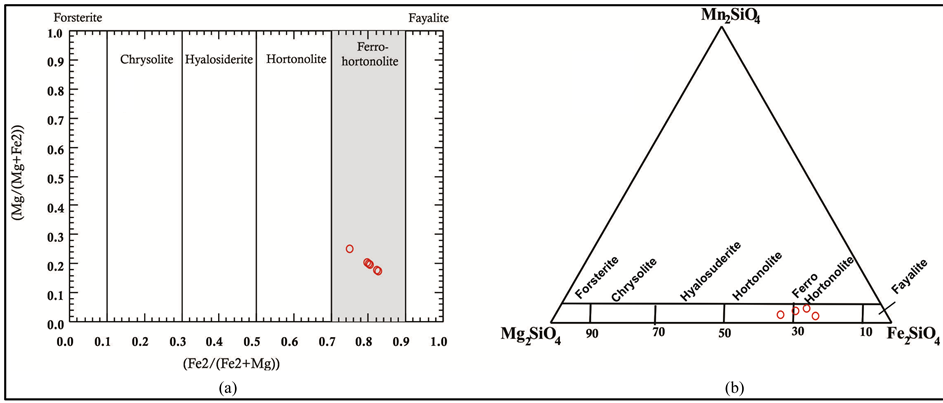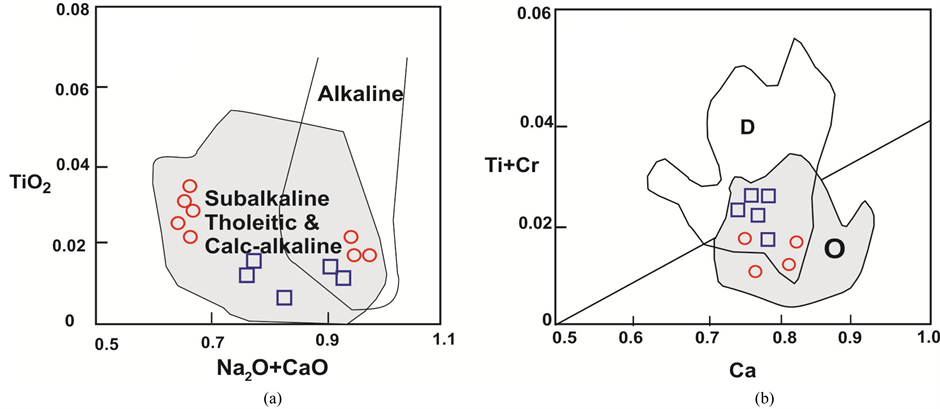Open Journal of Geology
Vol.04 No.12(2014), Article ID:52223,9 pages
10.4236/ojg.2014.412045
Mineral Chemistry and Thermobarometry of the Upper Eocene Volcanic Rocks in NE Tafresh, Iran
Neda Baranpurian1, Mohamad Hashem Emami2, Mansor Vossoughi Abedini1, Rahim Dabiri3*
1Department of Geology, Science and Research Branch, Islamic Azad University, Tehran, Iran
2Department of Geology, Islamshahr Branch, Islamic Azad University, Islamshahr, Iran
3Department of Geology, Mashhad Branch, Islamic Azad University, Mashhad, Iran
Email: *r.dabiri@mshdiau.ac.ir
Copyright © 2014 by authors and Scientific Research Publishing Inc.
This work is licensed under the Creative Commons Attribution International License (CC BY).
http://creativecommons.org/licenses/by/4.0/



Received 28 September 2014; revised 25 October 2014; accepted 20 November 2014
ABSTRACT
Petrography and chemistry of minerals show that rocks of Upper Eocene in northeast of Tafresh are composed mostly of andesitic basalt, basaltic andesite and andesite volcanic rocks. Mineralogically these rocks are composed of phenocrystals of olivine, clinopyroxene and plagioclase and main texture of them is porphyry with cryptocrystalline or microcrystalline matrix. In addition, aphyric and pitted textures (amygdala) are also observed. According to the results of EPMA, phenocrystals of plagioclase in mentioned rocks include a range of anorthite to albite minerals. Alkali feldspars also contain a range of sodic to potassic minerals. Pyroxene crystals include hedenbergite, augite and hypersthene. Olivine minerals are often of the ferrohornblendite type. Based on thermobarometry it is estimated that to form clinopyroxene crystals of basaltic andesite rocks, temperature between 750˚C to 1000˚C is needed. Andesitic basalt rocks at higher temperature (1100˚C) and andesite rocks at lower temperature (below 750˚C) are formed. According to the distribution of aluminum in clinopyroxenes, these minerals at pressures less than 5 kbar and water content between 5% to 10% are crystallized. The mineral composition indicates that these rocks are formed in a tensional environment.
Keywords:
Volcanic, Mineral Chemistry, EPMA, Thermobarometry, NE Tafresh

1. Introduction
Eocene volcanic occurrences are the most important volcanic demonstrations In Iran, because it has led to the creation of a volcanic arc which has a length of 1700 km and a width of 100 km [1] [2] . This volcanic arc which is known as the Urmia Dokhtar volcanic arc is widespread from northwest to southeast in Iran and is the most important volcanic zone of Iran [3] -[6] . Eocene volcanic occurrence in almost all regions, except Zagros and Kopet Dagh, took place [7] . One of the most complete volcanic sequences of the Urmia Dokhtar magmatic arc, with a thickness of over 3 km, is in the north and northeast Tafresh. Volcanic occurrences in this area have begun since Lutetian, so that these volcanic units are located on the Upper Cretaceous units [8] . The purpose of this article is to identify and determine the structural formulas of minerals in the Upper Eocene volcanic rocks of NE part of Tafresh (Figure 1).
2. Methods
In order to achieve the aims of this work, at the first field surveying and sampling was done, then thin and thin polished sections were prepared. About the rocks of area, 5 rocks include andesitic basalt, basaltic andesite and andesite were selected for microprobe analysis and their olivine, clinopyroxene and plagioclase minerals by using XGT-7200 micro-XRF analyzer-Horiba with voltage of 50 kv and a current of 3 mA in Kansaran Binaloud Laboratory were analyzed. A total of 80 points were analyzed which results of this analysis are given in Tables 1-3.
3. Geology of the Area
This area is located in Markazi Province with geographical coordinates to east longitude and to north latitude and is part of the magmatic zone of Urmia Dokhtar. Also, from structural and metallurgical viewpoint, it is located at the northwest corner of Central Iranian plate (Figure 2). The most ancient rock outcrops of the area are related to the Middle Triassic (Ladinian) time, which in Noghre Kamar defile are reached to the level by Tafresh fault [9] . Jurassic in north Tafresh only limited to Lower Jurassic and includes deposits made of shale and sandstone (Shemshak formation). In the Upper Cretaceous, because of orogenic event, sediments with a thickness of 1000 m and a basal conglomerate are located on old folded layers. Eocene in the studied area is very important, because in this period the volcanic activity starts and reaches its peak [10] . Eocene deposits included pyroclastic rocks, lava flows and some sedimentary rocks, which have a thickness of 3000 m. Based on sedimentary units between different phases of volcanism in the study area; Eocene series is classified into six distinct lithologic zones (Lithozone) [11] . This unit consists of basic and acidic lavas with a dominant andesite composition and
Figure 1. A simplified tectonic map shows the main tectono-magmatic features of the Iran and Eastern Anatoliaregions. UDMA―Urumieh-Dokhtar magmatic arc, SSMZ―Sanandaj Sirjan Metamorphic Zone, FZZ―Folded Zagros Zone.
Figure 2. Geological map of the study area which is taken from 1:100000 map of Tafresh [9] .
Table 1. Representative calculated mineral formulas of plagioclase minerals in the Volcanic Rocks in NE Tafresh.
Table 2. Representative calculated mineral formulas of pyroxene minerals in the Volcanic Rocks in NE Tafresh.
Table 3. Representative calculated mineral formulas of olivine minerals in the Volcanic Rocks in NE Tafresh.
alternative pyroclastic rocks of the basaltic-andesitic composition. In the Upper Eocene, magmatic activity is significant and mostly consists of basaltic andesite lavas with porphyritic texture along with tuff cuts, Ignimbrite and tuffit. In Oligocene-Miocene, it contains limestone-marly formation (Qom Formation) [12] . Magmatism at this time is mostly of basic to moderate types and partially occurred.
4. Volcanic Rocks Petrology
The studied volcanic rocks are in the hybrid domain of andesitic basalt, basaltic andesite and andesite. The main minerals of their constituents include phenocrysts plagioclase, clinopyroxene, olivine and Alkali feldspar (Figure 3). The texture of these rocks is porphyritic with microlitic to aphyric matrix and in some cases contains micro-
Figure 3. Some pictures of existence minerals in the rocks of the area. (a) A picture of Phenocrysts of olivine, pyroxene and plagioclase in an andesitic basalt rock. Olivines were altered to chlorite and just their psodomorph is retained. (b) Phenocryst of olivine in andesitic basalt which is containing a porphyric texture and a microlitic matrix. (c) Pyroxene Phenocryst in andesitic basalt. (d) A picture of phenocrystic plagioclase with reverse zoning (calcium-rich margin and sodium-rich center).
litic glassy matrix or pitted microlitic dough. Pores often are filled by secondary minerals such as calcite, chlorite and quartz and based on the petrographic features; plagioclases are automorphic to semi-automorphic crystals with eroded margins. In some cases in feldspars, carlsbad and albite and sometimes polysynthetic twining and zoning can be seen. Also in some cases plagioclases sometimes can be seen as megaporphyry crystals in the rocks. In some plagioclase, their margins are destroyed, while center of crystals are relatively intact (Figure 3). The pyroxene crystals are automorphic to heteromorphic phenocrysts as well as tiny crystals in the groundmass of rock. Microscopic features of these crystals indicate that their compositions are diopsiditic. We can see olivine phenocrysts in the andesitic basalt rocks (Figure 3). These phenocrysts are automorphic to heteromorphic shapes and are mostly seen as casts of olivine which are disintegrated to chlorite, serpentine and Iddingsite.
5. Chemistry of Minerals
The Upper Eocene volcanic rocks in Tafresh include andesitic basalt, basaltic andesite and andesite which have constituted significant volumes of lava in the region. Plagioclase feldspar, pyroxene and olivine are the major minerals in them. Plagioclase (60% - 70%) is as phenocryst and microlite. Plagioclase phenocrysts are mostly of calcic to sodic types and their anorthite component (Xan) vary between 0.05 to 0.98 (anorthite to oligoclase), (Figure 4). Petrographic studies of plagioclases also confirm that anorthite component of the andesitic basalt rocks is much more than that of other basaltic rocks. The potassium component (Xor) of plagioclase phenocrysts vary between 0.01 to 0.90 (albite to sanidine). Pyroxene phenocrysts are clinopyroxene and orthopyroxene. Pyroxene as orthopyroxene is the dominant phase in andesitic basalts. According to the classification of Deer, Howie and Zussman [13] the pyroxenes of andesitic basalts have hypersthene and pigeonite composition. However, calcic pyroxene (augite) is also seen. The basaltic andesite rocks contain iron pyroxene with a compositional range from En3Fs51Wo10 to En13Fs78Wo38 (Figure 5). The andesitic rocks are characterized by Ca-rich pyroxenes with hedenbergite composition which show compositional range from En2Fs43Wo38 to En12Fs51Wo46 (Figure 5). According to the classification of Morimoto [14] , pyroxenes often are located in the ranges of A and D. Two possible processes can explain the existence of iron-reach portion (hedenbergite-ferrosilite) in basaltic andesite and andesite rocks, (1) opacitization and oxidation of the pyroxenes with removal of calcium and magnesium as carbonate from minerals, and (2) remove of calcium as well as fixing magnesium in some clinopyroxenes. According to Figure 6 olivine ranges in composition from Fo19 to Fo24 show ferrohortonolite composition.
Figure 4. Feldspars composition ternary diagram from NE Tafresh.
Figure 5. (a)-(b) Q-J (from Deer, Howie and Zussman [13] ) and Quad (from Morimoto [14] ) classification diagrams for the pyroxenes in northeast Tafresh.
Figure 6. (a) Determination of the olivine types in the basic volcanic rocks of the study area. (b) Triangle diagram of Mn2SiO4-Mg2SiO4-Fe2SiO4.
6. Thermobarometry
Empirical and experimental studies indicate that mineral compositions can be effectively used to quantify the P-T conditions during crystallization [15] -[17] . So the researches proposed several ways such as Pyroxene-oli- vin, Amphibole-clinopyroxene and pyroxene-feldspare thermometer and pyroxene baromether for this meaning. To determine the temperature of clinopyroxene formation in the andesitic basalt, basaltic andesite and andesite rocks, clinopyroxene barometry has been used. According to Lindsley [18] graphical thermometer, andesitic basalts have been formed at 1100˚C (Figure 7). The basaltic andesite rocks are formed in the higher temperature ranges from 700˚C to 1000˚C. However the andesitic basalt rocks have the highest formation temperature of 1100˚C. Furthermore, also according to the Aoki and Shiba [19] and Helz [20] approaches, the pyroxenes of the study area are in a wide range of low pressure to medium pressure (Figure 8). This indicates their crystallization while are stopping during the magma ascent. The compositions of Al in clinopyroxene have been used to determine the depth of the magma chamber. According to these diagrams, the clinopyroxenes in intermediate to basic rocks have been crystalized at intermediate pressure (<5 kbar).
7. Evaluation of Oxygen Fugacity
Oxygen fugacity plays an important role in changing of the liquidus temperature, melt and crystals composition, magmatic processes controlling, crystallization sequence and types of crystallized minerals [21] -[24] . Using AlIV + Na vs AlIV + 2Ti + Cr diagram which depend on the amount of 3-valent iron in pyroxenes, we can get oxygen fugacity. The diagram is set based on the aluminum balance in the tetrahedral position with Cr3+ in the octahedral position. The Fe3+ in pyroxenes can be displaced 3-valence elements such as AlVI, Ti and Cr in the octahedral position. In the other hand Fe3+ in pyroxenes depends on the amount of AlVI which means it depends on the aluminum balance in tetrahedral and octahedral position. Figure 9 show that the pyroxenes which crystalized at high oxygen fugacity, has been situated above the line of Fe3+. Furthermore, Papike and Cameron [25] have mentioned to the distances of the samples from the Fe3+ line and noted that further distances of the samples from this line are indicating more oxygen frugalities in their geological setting. In this diagram some samples are located above the line of Fe3+ line and some are below that (Figure 9).
8. Tectonic Setting
Pyroxene composition depends on the chemical composition and tectonic setting of the host lava which can be used widely to determine geological setting of the rocks [27] [28] . Ti + Cr vs Ca and TiO2 vs Na2O + CaO diagrams define the pyroxenes which generated by tholeiitic and calc-alkaline magmas from those of alkaline. Plotting data on Ti + Cr vs Ca and TiO2 vs Na2O + CaO diagrams shows that the samples are subalkaline to alkaline tendency. Diagrams (Figure 10) indicate the extensional setting of the area when the rocks were formed.
Figure 7. Wo-En-Fs diagram of clinopyroxene to estimate temperature [18] .
Figure 8. (a) Clinopyroxene barometry diagram from [19] . (b) Clinopyroxenebarometry and hydrometry diagram from [20] .
Figure 9. Estimation of oxygen fugacity in pyroxenes [26] .
Figure 10. (a) TiO2-Na2O + CaO diagram (b) Ti + Cr-Ca diagram. Abbrivation: O-Volcanic arc Basalt. D-MORB and other tholeiites of extentional setting.
9. Conclusion
The andesitic basalts have the most calcic plagioclase in comparison with the other rocks and contain two coexisting clinopyroxene and orthopyroxene. Andesite rocks are defined by the most calsic pyroxenes in comparison with other rocks in the study area. Clinopyroxene thermobarometry diagrams suggest that basaltic andesites have been crystalized at <5 kbar pressure and a temperature between 750˚C - 1000˚C. The andesitic basalts and andesites have been crystalized at higher 1100˚C and lower (<750˚C) temperature respectively. According to the distribution of aluminum in clinopyroxenes, these minerals have been formed at <5 kbar pressure and water content between 5 to 10 percent. The mineral compositions of the rocks display an alkaline nature which indicates a tensional setting.
Acknowledgements
The authors appreciate the support received from the Islamic Azad University, Sciences and Researches Branch.
References
- Stocklin, J. (1968) Structural History and Tectonics of Iran: A Review. AAPG Bulletin, 52, 1229-1258.
- Shahabpour, J. (1982) Aspects of Alteration and Mineralization at the Sar-Cheshmeh Copper-Molybdenum Deposit, Kerman, Iran. Unpublished Ph.D. Thesis, University of Leeds, Leeds, 342 p.
- Alavi, M. (1980) Tectonostratigraphic Evolution of the Zagrosides of Iran. Geology, 8, 144-149. http://dx.doi.org/10.1130/0091-7613(1980)8<144:TEOTZO>2.0.CO;2
- Dabiri, R., Emami, M.H., Mollaei, H., Chen, B., Abedini, M.V., Omran, N.R. and Ghaffari, M. (2011) Quaternary Post-Collision Alkaline Volcanism NW of Ahar (NW Iran): Geochemical Constraints of Fractional Crystallization Pro- cess. Geologica Carpathica, 62, 547-562. http://dx.doi.org/10.2478/v10096-011-0039-2
- Ghaffari, M., Rashidnejad-Omran, N., Dabiri, R., Chen, B. and Santos, J.F. (2013) Mafic-Intermediate Plutonic Rocks of the Salmas Area, Northwestern Iran: Their Source and Petrogenesis Significance. International Geology Review, 55, 2016-2029. http://dx.doi.org/10.1080/00206814.2013.817067
- Ghaffari, M. and Rashidnejad-Omran, N. (2014) Magma Mixing/Mingling in Salmas Granodiorite, NW Iran: Evidence from Mafic Microgranular Enclaves. Arabian Journal of Geosciences, (in press). http://dx.doi.org/10.1007/s12517-014-1674-6
- Berberian, M. and King, G.C.P. (1981) Towards a Paleogeography and Tectonic Evolution of Iran. Canadian Journal of Earth Sciences, 18, 210-265. http://dx.doi.org/10.1139/e81-019
- Morley, C.K., Kongwung, B., Julapour, A.A., Abdolghafourian, M., Hajian, M., Waples, D., Warren, J., Otterdoom, H., Srisuriyon, K. and Kazemi, H. (2009) Structural Development of a Major Late Cenozoic Basin and Transpressional Belt in Central Iran: The Central Basin in the Qom-Saveh Area. Geosphere, 5, 325-362. http://dx.doi.org/10.1130/GES00223.1
- Hajian, H. (1977) Geological Map of the Tafresh Area: Tehran. Geological Survey of Iran, Scale 1:100,000.
- Sepahi, A.A. and Malvandi, F. (2008) Petrology of the Bouein Zahra-Naein Plutonic Complexes, Urumieh-Dokhtar Belt, Iran: With Special Reference to Granitoids of the Saveh Plutonic Complex. Neues Jahrbuch für Mineralogie-Abhandlungen: Journal of Mineralogy and Geochemistry, 185, 99-115. http://dx.doi.org/10.1127/0077-7757/2008/0104
- Hajian, J. (2001) Geology of Tafresh. Geological and Mineralogical Exploration Survey of Iran, Tehran.
- Keshavarzi, R., Esmaili, D., Kahkhaei, M.R., Mokhtari, M.A.A. and Jabari, R. (2014) Petrology, Geochemistry and Tectonomagmatic Setting of Neshveh Intrusion (NW Saveh). Open Journal of Geology, 4, 177-189.
- Deer, W.A., Howie, R.A. and Zussman, J. (1997) Single-Chain Silicates. Geological Society of London, London.
- Morimoto, N. (1988) Nomenclature of Pyroxenes. Mineralogy and Petrology, 39, 55-76. http://dx.doi.org/10.1007/BF01226262
- Berman, R. (1988) Internally-Consistent Thermodynamic Data for Minerals in the System Na2O-K2O-CaO-MgO-FeO- Fe2O3-Al2O3-SiO2-TiO2-H2O-CO2. Journal of Petrology, 29, 445-522. http://dx.doi.org/10.1093/petrology/29.2.445
- Mercier, J.C.C. (1980) Single-Pyroxene Thermobarometry. Tectonophysics, 70, 1-37. http://dx.doi.org/10.1016/0040-1951(80)90019-0
- Gasparik, T. (1984) Two-Pyroxene Thermobarometry with New Experimental Data in the System CaO-MgO-Al2O3- SiO2. Contributions to Mineralogy and Petrology, 87, 87-97. http://dx.doi.org/10.1007/BF00371405
- Lindsley, D.H. (1983) Pyroxene Thermometry. American Mineralogist, 68, 477-493.
- Aoki, K.-I. and Shiba, I. (1973) Pyroxenes from Lherzolite Inclusions of Itinome-Gata, Japan. Lithos, 6, 41-51. http://dx.doi.org/10.1016/0024-4937(73)90078-9
- Helz, R.T. (1976) Phase Relations of Basalts in Their Melting Ranges at
 = 5 kbar. Part II. Melt Compositions. Journal of Petrology, 17, 139-193.http://dx.doi.org/10.1093/petrology/17.2.139
= 5 kbar. Part II. Melt Compositions. Journal of Petrology, 17, 139-193.http://dx.doi.org/10.1093/petrology/17.2.139 - France, L., Koepke, J., Ildefonse, B., Cichy, S.B. and Deschamps, F. (2010) Hydrous Partial Melting in the Sheeted Dike Complex at Fast Spreading Ridges: Experimental and Natural Observations. Contributions to Mineralogy and Petrology, 160, 683-704. http://dx.doi.org/10.1007/s00410-010-0502-6
- Kilinc, A., Carmichael, I., Rivers, M. and Sack, R. (1983) The Ferric-Ferrous Ratio of Natural Silicate Liquids Equilibrated in Air. Contributions to Mineralogy and Petrology, 83, 136-140. http://dx.doi.org/10.1007/BF00373086
- Moretti, R. (2005) Polymerisation, Basicity, Oxidation State and Their Role in Ionic Modelling of Silicate Melts. Annals of Geophysics, 48, 583-608.
- Botcharnikov, R., Koepke, J., Holtz, F., McCammon, C. and Wilke, M. (2005) The Effect of Water Activity on the Oxidation and Structural State of Fe in a Ferro-Basaltic Melt. Geochimica et Cosmochimica Acta, 69, 5071-5085. http://dx.doi.org/10.1016/j.gca.2005.04.023
- Papike, J.J. and Cameron, M. (1976) Crystal Chemistry of Silicate Minerals of Geophysical Interest. Reviews of Geophysics, 14, 37-80. http://dx.doi.org/10.1029/RG014i001p00037
- Schweitzer, E., Papike, J. and Bence, A. (1979) Statistical Analysis of Clinopyroxenes from Deep-Sea Basalts. American Mineralogist, 64, 501-513.
- Kushiro, I. (1960) Si-Al Relation in Clinopyroxenes from Igneous Rocks. American Journal of Science, 258, 548-554. http://dx.doi.org/10.2475/ajs.258.8.548
- Nisbet, E.G. and Pearce, J.A. (1977) Clinopyroxene Composition in Mafic Lavas from Different Tectonic Settings. Contributions to Mineralogy and Petrology, 63, 149-160. http://dx.doi.org/10.1007/BF00398776
NOTES

*Corresponding author.


